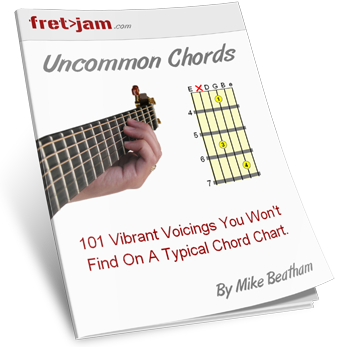Modes In Parallel
In music, parallel can be thought of as "on the same root note". For example, A major and A minor are parallel keys, because they share the same tonic root (A).
When we play two or more modes starting on the same root, with the same backing reference note, we can more easily hear and compare the different musical colours they offer.
For example, if we played A Dorian followed by A Phrygian, both minor modes, we'd instantly hear the difference between these two modes, even though there are only two notes difference...
Dorian
Phrygian
Note: We'll look more at changing between modes (sometimes called modal interchange or mode mixture) in a coming lesson, as this is a more advanced concept.
This "parallel" concept is the basis upon which the process outlined in this lesson is formed. Once you establish a fixed root note, your ear connects with a "center of musical gravity". We can call this the key center. From that center, we can really hear the unique colours each mode offers our music.
The ear is then trained to pick out the often subtle differences between the modes, which translates into other keys.
Modal Harmony
As well as melody, each mode creates its own compatible harmonic system. For example, each mode has its own sequence of chords, based on its intervals, that can be used to form chord progressions (parts of songs, essentially) and flows of harmony that invoke that mode's flavour.
It's quite difficult to explain, which is why ear training is the best way to get that "eureka" moment!
Using the parallel concept from the video, use the below patterns to create shapes (whether triads or other blocks of harmony from the three strings) and movements for each mode in A. Really explore and internalise their sound. I've provided tabbed examples for each one...
Ionian / Major Scale
The primary major mode around which most major key music is written (whether intentionally or not)...


With Lead
Without Lead
Lydian
Raise the 4th of Ionian to get the mysterious sounding major mode of Lydian. Try to absorb the sound of that ♯4 (augmented 4th) interval as you combine it with shapes up the neck...


With Lead
Without Lead
Mixolydian
Lower the 7th degree of Ionian for this commonly used major mode. Listen up whenever you touch on that ♭7 (minor 7th)...


With Lead
Without Lead
Aeolian / Natural Minor
The primary minor mode around which most minor key music is written...


With Lead
Without Lead
Dorian
Raise the 6th of Aeolian for the more "open" minor sound of Dorian. Can you describe the feeling when you touch on that 6 in a minor context?


With Lead
Without Lead
Phrygian
Lower the 2nd of Aeolian for this flamenco or middle eastern sounding minor mode. The ♭2 (minor 2nd degree) has a very harsh, tense quality...


With Lead
Without Lead
Modal Jam Tracks
Using the above method, I've created some five minute modal tracks (all in the key of A) which you can use to practice over (try both melody and harmonising using shapes from the above patterns), or just listen to help internalise each mode's unique sound and feel.
Major Modes
Ionian / Major Scale
Lydian
Mixolydian
Minor Modes
Aeolian / Natural Minor Scale
Dorian
Phrygian
How Ear Training Will Make You A Better Musician
Much of the time, we won't have visual cues for keys or chords. By training your ear to recognise common movements, you'll know which "system" the music you're listening to is formed around and be able to jump right in and play along or develop it.
You'll be surprised at just how much music uses these six modes (three major, three minor). That's not to say you should intentionally write your songs in a particular mode - that would be unnecessarily constraining.
But it's clear that composers and songwriters naturally gravitate towards these modes, even if they don't understand where these movements come from!
So it's hugely valuable to be able to recognise the "Dorian sound", the "Mixolydian sound" etc. as and when it arises, whether you're looking to add a solo or an accompanying harmony part.
